Knowledge
American Ginseng
Introduction:
American ginseng is the root part of ginseng, which belongs to the Panax genus in the Araliaceae family; it is mainly produced in the United States and Canada, and is also introduced in China, which the Chinese-grown American ginseng are called "planted western ginseng"; there are 2 types of American ginseng, "wild" and "planted", while the wild American ginseng is grown in the nature, planted American ginseng is artificially planted.
-
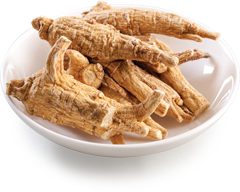 American ginseng → produced in the United States and Canada, has a light-yellow epidermal with rough texture, the circles on the cross-section are more obvious; it is bitter when first chewed, but a sweet aroma can be tasted gradually.
American ginseng → produced in the United States and Canada, has a light-yellow epidermal with rough texture, the circles on the cross-section are more obvious; it is bitter when first chewed, but a sweet aroma can be tasted gradually. - Western ginseng → produced in North-East China, has a greyish-yellow epidermal, the ginseng has a rather firm texture and weights relatively heavier, with less lines on the body surface, and a delicate chrysanthemum pattern can be observed on the cross-section; has a bitter but sweet taste.
- White dry ginseng → produced in North-East China, weights relatively less, has wider intervals between the lines on the body surface, and marks of nodes can be observed; has a faint and fishy taste.
Function:
Tonic for yin and qi, retreats the heat and heals the lungs, nourishes the stomach and promotes saliva; suitable for people who are weak, having asthenic fever and always thirsty, or suffering from dry mouth and qi deficient.
Standard:
Has a slightly bitter but sweet taste, cool in nature
- Cut the ginseng root into thin slices, wash with water and it can be used for cooking or as a drink with hot water as a substitute for tea.
- American ginseng can also be grinded into powder, to drink with hot water as a drink or to be added into soup.
Way of storage:
American ginseng should be stored under good ventilation and avoid sunlight. If planned to store for a longer period, please seal and put into the refrigerator (0-8˚C).
- American ginseng slices are more suitable for drinking with hot water as a substitute for tea. Add honey for better taste and this drink can treat deficient fire, heat and thirst.
Serving suggestions:
Make soup with 25g American ginseng, 10 heart-shaped jujubes, 1 snakehead, 600g lean pork. The soup has an effect of healing heart and treating blood deficient, treating swelling and promotes growth.
Korean Ginseng
Introduction:
Korean ginseng is the root part of ginseng, which belongs to the Panax genus in the Araliaceae family, and it is a type of red ginseng; there are 2 types of ginsengs, red ginseng and white ginseng, which the red ginseng is usually processed from ginseng of higher quality. Korean ginseng from Korea is the most well-known type, and it is produced in both South and North Korea, but Korean ginseng from North Korea is less common.
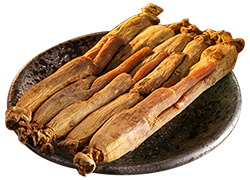 South Korean ginseng → produced in South Korea, and there are 3 grades of them → "Heaven", "Earth", and "Good", and it is further graded as "Cut" and "Tail". It has a straight cylindrical body, and the diameter of the head of the ginseng is almost the same as the body. There are thin horizontal lines on the body, and some vertical lines in the middle part. It has a hard and firm texture and a smooth cross-section. It has a strong aroma, tastes slightly bitter but sweet.
South Korean ginseng → produced in South Korea, and there are 3 grades of them → "Heaven", "Earth", and "Good", and it is further graded as "Cut" and "Tail". It has a straight cylindrical body, and the diameter of the head of the ginseng is almost the same as the body. There are thin horizontal lines on the body, and some vertical lines in the middle part. It has a hard and firm texture and a smooth cross-section. It has a strong aroma, tastes slightly bitter but sweet.- North Korean ginseng → produced in North Korea, and is classified into 4 grades: "Heaven", "Earth", "Man" and "Elderly", and can be further graded as "Tail", "Beard" and "Prong". "Heaven" is the best class and the ginseng has a relatively longer body and smoother surface.
- Korean white ginseng → produced in South Korea, and is also called "freshly dried ginseng". Unlike the Korean ginseng previously mentioned, there are no different grades for Korean white ginseng. Has a rather light yellowish or brown colour and a lighter and crispier texture compared to red ginseng. Has a sweet taste.
Function:
Korean ginseng helps promote qi, nourishes the spleen and lungs, has a calming and awaking effect. Suitable for people who are weak, having bad appetite, nervous depression, and for women who have just given birth to babies.
Standard:
Sweet but slightly bitter, warm in nature.
- Remove the head of the ginseng, cut into thick slices, wash with water and it is ready for cooking.
Way of storage:
For unopened packets, store under good ventilation and avoid sunlight. If already opened or sliced, please store in the refrigerator (0-8˚C).
- The thicker the ginseng the better it is. Never eat the head and body of the ginseng at the same time since they have opposite functions. The head of the ginseng can be boiled with water, which treats deficient fire and toothache.
Serving Suggestions:
make soup with 10g Korean ginseng, 20g deer tail, 5 heart-shaped jujubes, 1 tsp rice wine, 1 chicken. Promotes growth of bones and treats deficient of qi.
Wild American Ginseng
Introduction:
Wild American ginseng is the dried root of ginseng, which belongs to the Panax genus in the Araliaceae family. It is a type of white ginseng and is mainly produced in North America and Canada. They can be generally categorized into "soaked ginseng → main root"; they are graded in terms of sizes as No.1, No.2, No.3, No.4, etc, and can also be graded in terms of quality as "soaked surface" or "soaked ginseng", "cut surface → side roots and scattered pieces", "red flesh → ginseng beard" 3 main types.
-
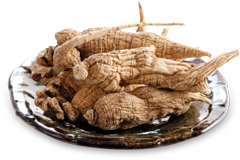 Wild American ginseng – produced in America, has an irregular shape, there are dense black horizontal lines on the epidermal, with more lines when getting closer to the top. The colour of the ginseng depends on the type of soil it is grown in, but usually they are greyish-yellow; inner layers appear white. Wild American ginseng has a light and loose texture, with an aromatic sweet taste. Those with dense horizontal lines and light weight are of high quality.
Wild American ginseng – produced in America, has an irregular shape, there are dense black horizontal lines on the epidermal, with more lines when getting closer to the top. The colour of the ginseng depends on the type of soil it is grown in, but usually they are greyish-yellow; inner layers appear white. Wild American ginseng has a light and loose texture, with an aromatic sweet taste. Those with dense horizontal lines and light weight are of high quality. - Wild American ginseng beard – produced in America, is the processed small branched roots of wild American ginseng. Has an aromatic sweet taste and is rather economical for making soup or boiling with water.
Function:
Wild American ginseng promotes vital energy and strengthens the body. It is a tonic for yin and lungs, retreats the heat and promote saliva secretion. It is good for coughing with little phlegm due to deficiency of yin and kidneys, especially suitable for people who are too weak and cannot .
Characteristics:
Sweet and slightly bitter, mild in nature.
- imported directly from North America, [excellent quality from its origin] is guaranteed.
- using the "pieces system" to strictly control the standards, [fulfilling the quality requirement] is guaranteed.
- using a metal detector for screening, [absolutely no metal contamination] is guaranteed.
- slice the wild American ginseng, wash with water, and it is ready for cooking or boiling with water
- wild American ginseng can also be grinded into powder, suitable for adding in hot water as a substitute for tea or adding into soup.
Way of storage:
Wild American ginseng should be stored under good ventilation avoiding the sunlight. If planning to store for a longer period, please seal and store in the refrigerator (0-8˚C).
Other notes:
Wild American ginseng is excellent for removing tiredness and recovering physical strength, it grows much slower than artificially planted American ginseng. The larger the ginseng the more rare it is, and the better the effect it gives.
Serving suggestions :
Make soup with 2 maces wild American ginseng, 5 maces bird's nest, 5 maces Thai longan flesh, 5 heart-shaped jujubes, 1 silkie. Is a tonic for yin and promotes vital energy, nourishes the lungs and gives youthful complexion.
Red Ginseng
Introduction:
Red ginseng is the root part of ginseng, which belongs to the Panax genus in the Araliaceae family. There are 2 types of ginseng, white ginseng and red ginseng; white ginseng is produced by washing and drying freshly-grown ginseng directly, while red ginseng is steamed and dried high quality fresh ginseng, which is mainly produced in the Jilin area in China. Ginseng produced from Shizhu district in Jilin is called "Shizhu ginseng"
-
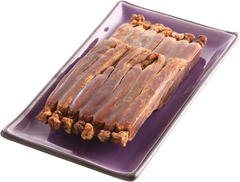 Red ginseng strips – the main root is cylindrical, the epidermal is reddish-brown, appears translucent and occasional opaque brown patches. There are vertical lines on the epidermal but horizontal lines are not obvious. It has branched roots and the there is a node on the top. It appears orchid brown, has a weak aroma and a slightly bitter but sweet taste.
Red ginseng strips – the main root is cylindrical, the epidermal is reddish-brown, appears translucent and occasional opaque brown patches. There are vertical lines on the epidermal but horizontal lines are not obvious. It has branched roots and the there is a node on the top. It appears orchid brown, has a weak aroma and a slightly bitter but sweet taste. - Straight red ginseng beard – appears reddish-brown, has a cylindrical body. The edges are wavy, with thicker branched roots tied into small bunches. Has a hard and crispy texture, an aromatic bitter taste, and is suitable for making soup or boiling with water.
- Curved red ginseng beard – appears reddish-brown, has thinner branched roots and is curved and cluttered into a ball. Has a hard and crispy texture, with an aromatic bitter taste and functions better than straight red ginseng beard.
Function:
Red ginseng is a tonic for qi, nourishes the spleen and lungs, and has a calming and awakening effect. Suitable for treating spleen deficiency, sweating, insomnia, bad memory and nourishing weak body after recovering from illness.
Standard:
Sweet and slightly bitter, warm in nature.
Processing method:
Remove the node of the ginseng, cut into thick slices, wash with water and it is ready for use.
Way of storage:
Store the ginseng under good ventilation and avoid sunlight. If plan to store for a longer period, please seal and put it into the refrigerator (0-8˚C).
Other notes:
Mass production of ginseng in provinces such as Jilin in North-East China is very popular in recent years. A lot of "fresh ginsengs", with a fresh and sweet taste are also exported as a perfect ingredient for cooking.
Serving Suggestions:
Make soup with 25g red ginseng, 50g Henan huai shan, 50g white lotus seed, 25g Thai longan flesh, 1 silkie; is a tonic for qi and spleen and has calming effect.
Wild American ginseng liquor
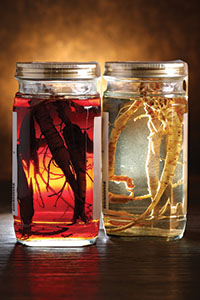 Description:
Description:
Wild American ginseng liquor is a tonic made by soaking wild American ginseng, that grows in uninhabited forests, especially in the cold northeastern America.The Native Americans have known the applications of the local ginseng and treasured it since a long time ago. Nowadays the active ingredients of the wild ginseng called Saponins have been discovered and its value confirmed by science. Each ginseng root is unique by its appearance, and each wild ginseng root is at least five years old. (For conservational reasons the U.S. Department of Agriculture has forbidden the unearthing of wild ginseng roots below the age of five years.) A strong demand for wild ginseng from Chinese people combined with a year-by-year decline in the production has been causing its prices to keep rising.
Effects:
Wild American ginseng liquor is a tonic made by soaking wild American ginseng in liquor for half a year in order for it to better release its active ingredients into the alcohol to then be carried more easily to the human body. Moderate consumption can have the effects of replenishing vital energy, improving blood circulation as well as strengthening and benefiting the essence.
Note: The wild American ginseng in this product has been excavated by hand after having grown from five to eight years or more, and is extremely rare. The ginseng used are large and with clear lines, and have been cleaned and soaked in French Martell VSOP cognac or special rice liquor for three months or over, in order to best release the essence of the ginseng into the liquor.
